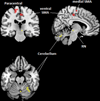Alterations in resting state oscillations and connectivity in sensory and motor networks in women with interstitial cystitis/painful bladder syndrome
- PMID: 24681331
- PMCID: PMC4432915
- DOI: 10.1016/j.juro.2014.03.093
Alterations in resting state oscillations and connectivity in sensory and motor networks in women with interstitial cystitis/painful bladder syndrome
Abstract
Purpose: The pathophysiology of interstitial cystitis/painful bladder syndrome remains incompletely understood but is thought to involve central disturbance in the processing of pain and viscerosensory signals. We identified differences in brain activity and connectivity between female patients with interstitial cystitis/painful bladder syndrome and healthy controls to advance clinical phenotyping and treatment efforts for interstitial cystitis/painful bladder syndrome.
Materials and methods: We examined oscillation dynamics of intrinsic brain activity in a large sample of well phenotyped female patients with interstitial cystitis/painful bladder syndrome and female healthy controls. Data were collected during 10-minute resting functional magnetic resonance imaging as part of the Multidisciplinary Approach to the Study of Chronic Pelvic Pain Research Network project. The blood oxygen level dependent signal was transformed to the frequency domain. Relative power was calculated for multiple frequency bands.
Results: Results demonstrated altered frequency distributions in viscerosensory (post insula), somatosensory (postcentral gyrus) and motor regions (anterior paracentral lobule, and medial and ventral supplementary motor areas) in patients with interstitial cystitis/painful bladder syndrome. Also, the anterior paracentral lobule, and medial and ventral supplementary motor areas showed increased functional connectivity to the midbrain (red nucleus) and cerebellum. This increased functional connectivity was greatest in patients who reported pain during bladder filling.
Conclusions: Findings suggest that women with interstitial cystitis/painful bladder syndrome have a sensorimotor component to the pathological condition involving an alteration in intrinsic oscillations and connectivity in a cortico-cerebellar network previously associated with bladder function.
Keywords: brain mapping; cystitis; interstitial; magnetic resonance imaging; pain; urinary bladder.
Copyright © 2014 American Urological Association Education and Research, Inc. Published by Elsevier Inc. All rights reserved.
Figures




Similar articles
-
Bladder Distension Increases Blood Flow in Pain Related Brain Structures in Subjects with Interstitial Cystitis.J Urol. 2016 Sep;196(3):902-10. doi: 10.1016/j.juro.2016.03.135. Epub 2016 Mar 24. J Urol. 2016. PMID: 27018508 Free PMC article.
-
Gamma-band Intermuscular Connectivity Is Associated With Increased Neural Drive to Pelvic Floor Muscles in Women With Interstitial Cystitis/Bladder Pain Syndrome.J Urol. 2023 Sep;210(3):465-471. doi: 10.1097/JU.0000000000003554. Epub 2023 Jul 7. J Urol. 2023. PMID: 37285231
-
Increased brain gray matter in the primary somatosensory cortex is associated with increased pain and mood disturbance in patients with interstitial cystitis/painful bladder syndrome.J Urol. 2015 Jan;193(1):131-7. doi: 10.1016/j.juro.2014.08.042. Epub 2014 Aug 14. J Urol. 2015. PMID: 25132239 Free PMC article.
-
Patients with chronic pelvic pain: endometriosis or interstitial cystitis/painful bladder syndrome?JSLS. 2007 Apr-Jun;11(2):182-9. JSLS. 2007. PMID: 17761077 Free PMC article. Review.
-
Pathophysiology of interstitial cystitis.Int J Urol. 2019 Jun;26 Suppl 1:12-15. doi: 10.1111/iju.13985. Int J Urol. 2019. PMID: 31144735 Review.
Cited by
-
Multivariate morphological brain signatures predict patients with chronic abdominal pain from healthy control subjects.Pain. 2015 Aug;156(8):1545-1554. doi: 10.1097/j.pain.0000000000000196. Pain. 2015. PMID: 25906347 Free PMC article.
-
Relationship of Pain Catastrophizing With Urinary Biomarkers in Women With Bladder Pain Syndrome.Female Pelvic Med Reconstr Surg. 2021 Dec 1;27(12):746-752. doi: 10.1097/SPV.0000000000001041. Female Pelvic Med Reconstr Surg. 2021. PMID: 33787562 Free PMC article.
-
Quantitative assessment of nonpelvic pressure pain sensitivity in urologic chronic pelvic pain syndrome: a MAPP Research Network study.Pain. 2019 Jun;160(6):1270-1280. doi: 10.1097/j.pain.0000000000001505. Pain. 2019. PMID: 31050659 Free PMC article.
-
Impact of early adverse life events and sex on functional brain networks in patients with urological chronic pelvic pain syndrome (UCPPS): A MAPP Research Network study.PLoS One. 2019 Jun 20;14(6):e0217610. doi: 10.1371/journal.pone.0217610. eCollection 2019. PLoS One. 2019. PMID: 31220089 Free PMC article.
-
OPRM1 A118G polymorphism modulating motor pathway for pain adaptability in women with primary dysmenorrhea.Front Neurosci. 2023 Jun 12;17:1179851. doi: 10.3389/fnins.2023.1179851. eCollection 2023. Front Neurosci. 2023. PMID: 37378013 Free PMC article.
References
-
- Clemens JQ. Male and female pelvic pain disorders--is it all in their heads? J Urol. 2008;179:813. - PubMed
-
- Mayer E, Bushnell M. Functional pain disorders: Time for a paradigm shift? In: Mayer E, Bushnell M, editors. Functional Pain Syndromes: Presentation and Pathophysiology. Seattle: IASP Press; 2009.
-
- Kutch J, Yani M, Cossand L, et al. Altered neuromotor connectivity in men with urologic chronic pelvic pain syndrome: A Trans-MAPP neuroimaging study. Journal of Urology. submitted.
Publication types
MeSH terms
Grants and funding
- U01 DK082345/DK/NIDDK NIH HHS/United States
- U01 DK082315/DK/NIDDK NIH HHS/United States
- DK82342/DK/NIDDK NIH HHS/United States
- R01 DK04835/DK/NIDDK NIH HHS/United States
- DK82370/DK/NIDDK NIH HHS/United States
- U01 DK082344/DK/NIDDK NIH HHS/United States
- U01 DK082333/DK/NIDDK NIH HHS/United States
- DK82315/DK/NIDDK NIH HHS/United States
- DK82344/DK/NIDDK NIH HHS/United States
- U01 DK082325/DK/NIDDK NIH HHS/United States
- K01 DK085133/DK/NIDDK NIH HHS/United States
- U01 DK082370/DK/NIDDK NIH HHS/United States
- U01 DK082342/DK/NIDDK NIH HHS/United States
- DK82345/DK/NIDDK NIH HHS/United States
- DK82316/DK/NIDDK NIH HHS/United States
- U01 DK082316/DK/NIDDK NIH HHS/United States
- K23 DK073451/DK/NIDDK NIH HHS/United States
- U24 DK082316/DK/NIDDK NIH HHS/United States
- DK82333/DK/NIDDK NIH HHS/United States
- U24 DK082333/DK/NIDDK NIH HHS/United States
- DK82325/DK/NIDDK NIH HHS/United States
LinkOut - more resources
Full Text Sources
Other Literature Sources
Medical

